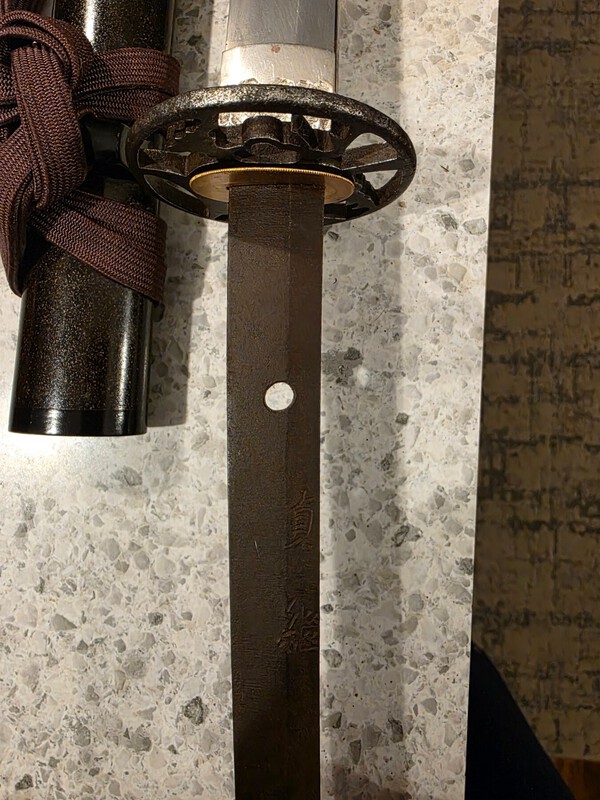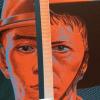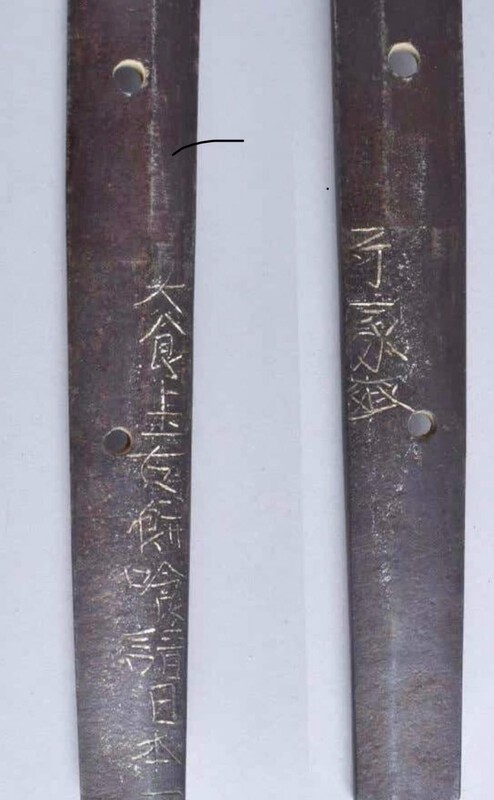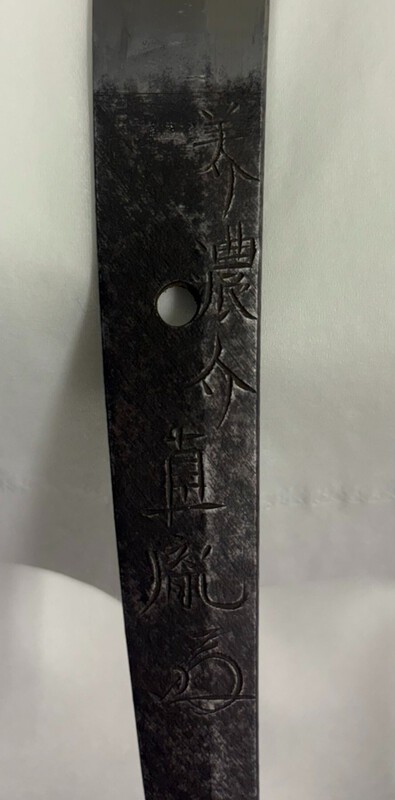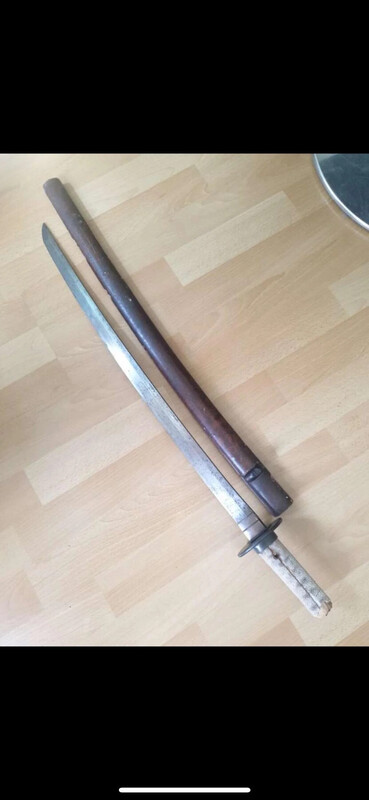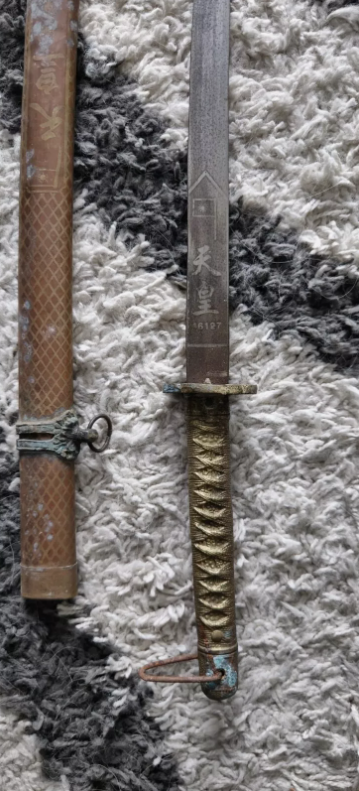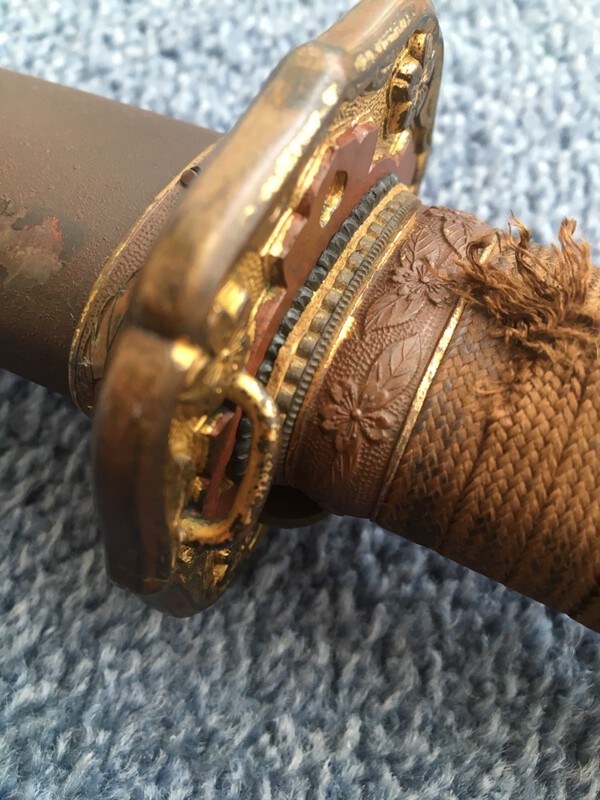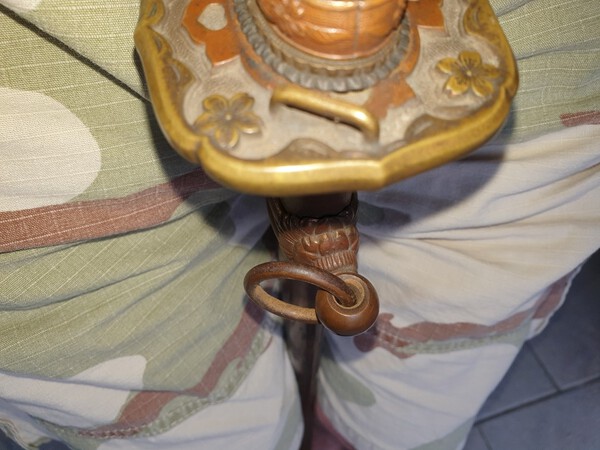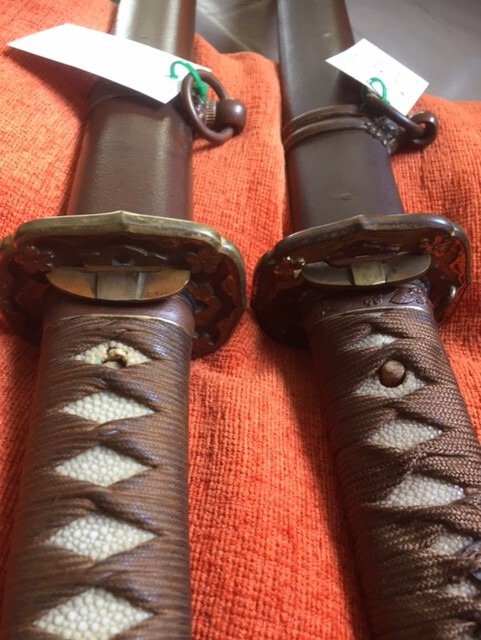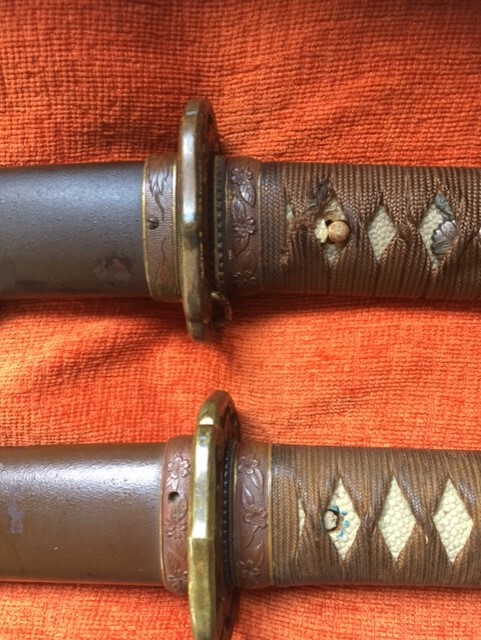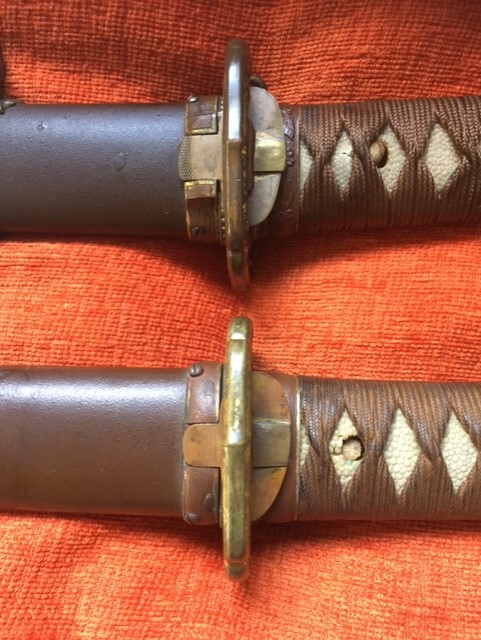Search the Community
Showing results for tags 'katana'.
-
Hello gents, I traded recently one of my swords for a splendid Kurihara Akihide katana, which was also introduced recently in the thread high class gunto by its previous owner. The sword was made in February 1945 and comes with the original shingunto koshirae. The mounts are in minty condition and look amazing. Everything works perfectly and is as good as it can be. The katana was recently polished by David Hofhine. Here are the measurements: Nagasa: 66,67cm Motohaba: 3,3cm Sakihaba: 2,31cm Motokasane:0,71cm The blade resides currently in Germany and can be shipped internationally. Payment should be done with bankwire or PayPal. The parcel can be shipped with DHL premium international, Fedex, or UPS. My asking price is 6300€ obo plus shipping and fees. Here is the link to the mentioned thread:https://www.militaria.co.za/nmb/topic/18610-show-us-your-high-class-gunto/page/21/
-
Just looking for thoughts on the legitimacy of this. The leather coverings for the Saya is making me raise some eyebrows and these little markings near the habaki I’ve never seen before on type 98’s
-
Hi, I found this Nihonto on Ebay. Price is about 800 EUR. Nagasa is 69cm Do you think it is a katana or a tachi? In Handachi Koshirae. Is it worth the price? The seller told me it was in the estate of a british military senior officer. What do you think about the sword (age, school, health of the blade)? Are the fitting of a decent quality? I already asked the seller to make better photos of the whole blade and I will post them here. Better and more photos are on the Google Drive: https://drive.google.com/drive/folders/18-rPblXj7Z0nIi0ktWccRA2hX-y0a5fL?usp=sharing
-
Hi guys selling this beautiful ubu Tadahiro katana and koshirae, don't hesitate to reach out if you want high res/more pics. Tadahiro is the son of Shodai Tadayoshi. He was born in Saga, Hizen in 1614 and he studied under his father (from the age of 10!) and other great smiths such as the first generation Masahiro, and Yoshinobu. When his father died in 1632, Tadahiro took up the reins for the school. He received his title of Omi Daijo in 1641 - a very unusual honour to receive at the young age of 28. The short time to receiving this title is probably an indication of how prolific the school was in producing fine swords, and the prestige it earned for the Nabeshima Daimyo. Nidai Tadahiro passed away at the age of 81 in the sixth year of Genroku or 1693. His sword-making career spanned over sixty years and resulted in him being the most prolific artisan among the Hizen smiths. Smith Ratings: Fujishiro’s reference: Jo Jo Saku (Above Superior made) Hawley’s: 70 points Toko taikan / Dr Tokuno: 800 man yen (very highly regarded) Sharpness rating: Kokan Kaji Biko by Yamada Asaemon- rated as O Wazamono (formidable cutting ability). Nidai Tadahiro’s forte is his skill in producing suguha hamon. Sword specifications Type : Katana Mei : HIZEN KUNI JÛ FUJIWARA TADAHIRO 肥前国住藤原忠廣 Paper : NBTHK Tokubetsu Hozon Era/Age : between 1633 and July 1641 Shirasaya : Sayagaki by Tanobe sensai Koshirae : Yes Nagasa / Blade Length : 74.5cm Nakago : Length 20.8cm. Ubu. Nakago-jiri is iri-yamagata. Yasurime are kiri Sori : 1.2cm Moto haba: 3.19cm Saki haba: 2.01cm Kasane: 6.64mm Hamon Type : Suguha Jihada : Konuka Other Hataraki Visible : Ashi and yo, some small kinsuji Flaws : Small oil stain in kissaki/boshi on one side (see pic), some small light scratches Sword Location : Australia Will ship to : Anywhere, shipping fees / any customs duties etc responsibility of buyer Payment Methods Accepted : Bank transfer Price and Currency : USD $17,500 Other Info and Full Description : This is a large Shinto Katana with good length and in very good polish. Very consistent suguha noiguchi and a beautiful example of a Hizen blade by the Nidai Tadahiro as mentioned by Tanobe sensai. Sayagaki translation Hizen-no-kuni Fujiwara Tadahiro Ubu with eight-character signature. An early work of the Tadahiro 2nd. The jitetsu of konuka hada, and the clear, belt-like suguha are excellent, and show off this smith's true abilities. This piece was made circa Kan'ei 14 (1637), before Tadahiro received the title of "Ōmi daijō" Length of two shaku, four sun, six bu. Appraised and written on this day in November, 2009, by Tanzan Hendō.
-
I am listing my Juyo Token blade for sale with the consent of my instructor, Tatsuhiko Konno-sensei. This is a fine example of a Taima blade (mumei) dating from the late Kamakura period. This blade was awarded Juyo Token at the 67th NBTHK evaluation. The blade comes with a shirasaya, oshigata, and a double-layer, gold-plated habaki. Type (Tachi, Katana, Wakizashi, Tanto, Naginata, Other) : Katana Ubu, Suriage or O-Suriage : Suriage Mei : (Mumei, Signature) : Mumei Papered or not and by whom? : Juyo Token, 67th NBTHK Era/Age : Late Kamakura Period Shirasaya, Koshirae or Bare Blade? : Shirasaya Weight: 610 g Nagasa/Blade Length : 61.9 cm Sori : 1.3 cm Mekugi-ana: 3 Width at base: 3.0 cm Width at tip: 2.2 cm Thickness: 0.6 cm Hamon Type : Suguha Jihada : Mokume-hada Other Hataraki Visible : Nioi-guchi Flaws : N/A Other Info and Full Description : The blade was judged as belonging to the Taima school. The Taima school is one of the 5 Yamato schools, along with Hosho, Senjuin, Shikkake, and Tegai. Yamato den swords are quite uncommon, and those of the Taima are especially uncommon. Despite (or perhaps partially due to) their rarity, Taima blades often trickle up to Juyo status. This blade has a large suriage, but the fundamental characteristics of the blade are clear to see. Namely, the polish brings out the fantastic Taima school mokume hada - on a personal note, I have studied many blades under my instructor, and have never seen one with such beautiful and apparent hada as this. The hamon of the blade is of course suguha, but has a deep nioi-guchi. I like to think of suguha hamon as a ZNKR seitei kata - though standard in outward appearance between many blades, the execution truly distinguishes masters. I hope this blade may become a fine part of your collection. Sword Location : Seattle, WA Will ship to : US (need to research for overseas, my first time!) Payment Methods Accepted : Bank Wire (open to discussion) Price and Currency : $22,000 USD This is a price I will have to consult with my instructor on, but am open to discussion. Unfortunately, given the current political climate in the US, there may be a hefty surcharge on any blades coming in the future.
-
Came across this sword and I'm trying to find out some more info on it. Translation, era, etc... thanks in advance
-
I know we have a separate topic of Show Us Your High Class Gunto. But many WW2 swords smiths have made nice traditionally made blades from 1876-1945. With members like "mecox" doing spectacular research on WW2 sword smiths, I think this new topic could throw some light on some sword smiths and their work, and hopefully kindle interest in the blade, not just the Koshirae. You never know, we may find some rare or poorly documented swords and smiths. If your posts could be supported by photos, oshigata, descriptions, and any other relevant information, I think a great reference topic could be established. OK, so here is a contribution to kick things off.... A (Mano) MASAYASU medium-grade grade gendaito, no date no stamps, in early '98 mounts. Mei reads Bishu ju Masayasu. The hada is flowing masame/mokume, with choji gunome midare hamon. I only hope there are better photographers out there! So I would ask the forum administrators to let this thread run, and see where it goes, a lot of time is spent discussing Chinese fakes, and machine made Showa-to, and I am sure this topic will help raise intertest in Gendai. P.S. Hamon looks Suguha in photos, but the Keisho polish disguises the features, easily seen in the hand.
-
Hello, I am new to this board, although I've been lurking for a while—haha. So please forgive me if I use some of the terminology incorrectly, and feel free to correct me. I was recently able to purchase a Type 98 Guntō at an auction. Although I am not completely sure if it's genuine, I still like it. I do think it's quite old, but I have my doubts about its authenticity. I noticed that the tsuka-ito is wrapped a bit irregularly, and a screw was used instead of a mekugi. Furthermore, there are no markings, stamps, or mei on the tang. And the Tang appears to have been shortened, but it does not look like the tang of an old blade. I had a very difficult time removing the tsuba, and I have found it to be impossible to remove the haba haha. But the sword is magnetic (as is the saya), and I think I can see the hada, though it's difficult to say for sure due to the oil used by the previous owner, which has turned the entire blade a copper color. Because of this, I also cannot really see the hamon at all. I wish to clean the blade of the previous oil and apply machine oil with a little bit of clove oil. However, I wanted to ask if cleaning it with isopropyl alcohol is the best way. I can take more pictures if needed or wanted. I'll take additional pictures regardless once I've cleaned the blade. Thank you in advance. Kind regards, D. Knol
-
Do you know any techniques that a swordsmith can do to reduce the damage when folding a katana made of modern steel?, as you know modern steel is already pure and dont need folding, the folded ones are only for Aesthetics like (hada) appearance or just Japanese traditions, so folding it reduce the carbon content as the result of repeated heating which is also known as (annealing the steel), i heard that you can fold it but with certain techniques that reduce the loss of carbon, i already know about the tatara furnace but modern steel katanas mostly isnt made in it cuz its an Expensive and time consuming method for a modern katana.
-
Hey guys, This sword has been laying around my house for a while and I have tried (unsuccessfully) to translate the mei. No idea whether the sword is authentic or not but any help would be greatly appreciated. Thanks!
-
-
Hi all, I need your expertise/opinions on the following nakago, whether real or fake. The blades have a certificate but as you know papers can be forged. Katana (.heic files): Katana - Google Drive Wakizashi (.heic): Wakizashi - Google Drive Certificate (.heic): Chiba 10078-10079 - Google Drive What worries me is Naotane's monogram on the katana, the way mekugi ana takes a portion of it. What do you think? I've found some examples on genuine meis but it look Naotance modified his signature over the years. I am attaching the jpg version of the pictures.
-
Hello everyone! A few months ago, I purchased a Nihontō in koshirae from a consignment sale in Japan (from a “go-between” dealer) and just received export approval from the Cultural Ministry. While I wait for it to arrive, I was hoping to find out a little more about the age and smith. I did try to do my own research before I purchased, feeling pretty confident it was indeed a Nihontō (aside from the fact that I was purchasing from Japan with papers…but you never know). Thanks to another member of the community, I was able to discover it had an nijimei of “兼直”. On the Nihontoclub website, I was able to find a few smiths using this name, but the dates are a bit all over the place. Im not expecting this blade to be from the 1400-1500s (despite being pretty out of polish), but it doesn’t seem like a 1935-1945 blade either…it’s missing a stamp (could be worn off?), and I haven’t seen many Showato with nijimei (though I am also very much a beginner). Also, I’m under the impression that Showato are more than likely not being sold IN Japan, even as exports, but I know that is debated. While the fittings may not be from this blade originally, maybe they’ll help date it? The tsuba looks Edo period based on the shape and style (chrysanthemum and heavily circular shape, but i could be wrong!)… I can take much better pictures when I receive it, but in the meantime, I’d love to get some thoughts here. Thanks!
-
Hi, I bought this nihonto last year from an estate in Vienna/Austria. The old owner died and unfortunately if he had papers, they are gone. What age and school could it be?I am wondering what thype of Nihonto it is? Someone said it is possible a Katateuchi. It is too long for a wakizashi and the nakago is too short for a Katana. What style and school of Koshirae is it (beside the fact that the Koshirae in which is was is in very bad shape). Nagasa is 60,6cm long and Nakago about 14cm. In the following google drive link are more pictures. https://drive.google...rj_DaQ3w?usp=sharing Hope you can help me
-
-
Got mine some years ago.. Now in the Mokuhankan fleamarket for sale.. https://mokuhankan.c...p?item_number=252911
-
Good quality IJA WW2 swords in very good condition are getting rarer. Swords with a great blade made by one of the best Gendai sword smiths of the era are super rare, collectable and are good investments, as good traditionally made Gendai-to are now being recognized for their aesthetic value. In the less common aluminium saya, magnificant fittings with the original coloring intact, handle binding is original and intact. A very high quality original sword. Being the light weight softer aluminium saya, there is a little paint loss, but shows its original patina for a sword taken to war. The blade is outstanding, showing its hamon and Ko Itame hada, and is still ubu-ba. Made in May 1941, the Mei reads Hachi-Man Dai-Satsu "The God of War"! No rust, no pits, no chips, a blade to enjoy. At USD2600, posted to you, it would be a great addition to the collector and investor.
-
On a small percentage of '98 tsuba, there is an appendage that is a small loop of brass, that is always in the same place. I doubt it has anything to do with a locking mechanism as all the swords have a lock of some kind. The examples here have a push button lock, the other an Iida lock. Can anyone help with identification?
-
See photos. I have some of the uncommon Iida latch type Guntos and have a question about their differences in design. There are subtle differences in their design and function. No knurling on one, no patent number on another, different hardware used. I was told that the one with no numbers could be a prototype or a manufacture before patents were issued. It may also be from another manufacturer as there are many subtle design differences between the two. Any help would be appreciated.
-
ALL Japanese Swords on StCroixBlades.com site ON SALE starting now! https://stcroixblade...hop/Japanese-swords/ Additional Japanese Swords ON SALE in St. Croix Blades' eBay Store! (you don't need to be an eBay member to purchase--just Contact St. Croix Blades on our site, or by emailing info@stcroixblades.com, or calling/texting 715-557-1688). https://www.ebay.com...ificSeller=1&_sop=16 If you have any questions, let me know. Sincerely, Matthew Brice St. Croix Blades
-
Greetings everyone, Recently I've come to purchase an old beater blade for martial arts purposes, but I'm now I'm not entirely sure if it truly is a fake or a very botched nihonto. Given some of the confusing details, I hope someone more experienced could help ease my doubts on this piece. P.D Tried my best with pictures, sadly camerawork is hard to balance with these fingers 😅 Kind Regards, Maurice
-
Recently at the advice of a friend with shared interest in the preservation of nihonto, I’ve tried and now implemented the use of 99% isopropyl alcohol in my sword care regimen. I’ve used it, rather than uchiko or anything so abrasive, to remove old oil at the start of a cleaning or before studying my blades. My test run was on a showato I posses, and with great result I have since implemented it for use with my nihonto. A partially saturated, folded tissue paper wiped gently across a sword does a fantastic and quick job of removing old oil and evaporating. A single follow-up wipe with dry tissue paper or a microfiber cloth ensures dryness and gets up any remaining bits. The blade is left perfectly cleaned, an unharmed. Everything in moderation, of course. Attached is a photo of my gendai Hizen-tō after such treatment. V/R, Jim
- 25 replies
-
- 4
-


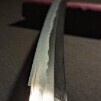


.thumb.png.320330ff1e064e2c5297335697960cc0.png)











.thumb.jpg.fdad68c82b2fded068a755c96ef1d6cc.jpg)






